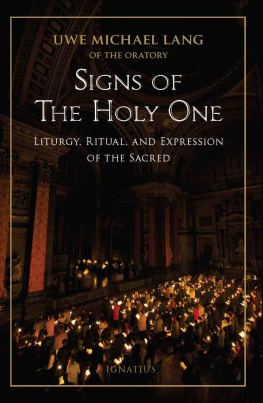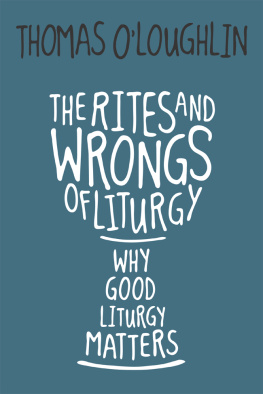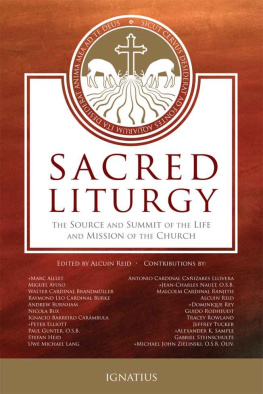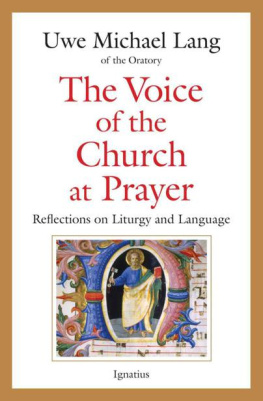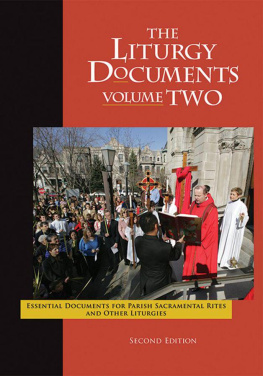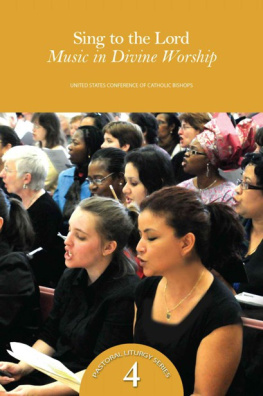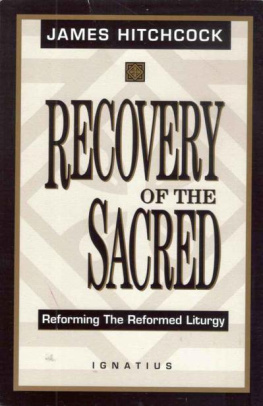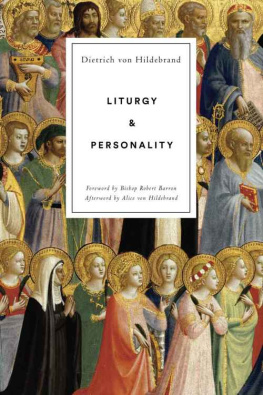SIGNS OF THE HOLY ONE
UWE MICHAEL LANG
Signs of the Holy One

Liturgy, Ritual, and the
Expression of the Sacred
IGNATIUS PRESS SAN FRANCISCO
Scripture quotations are from Revised Standard Version of the BibleSecond Catholic Edition 2006 by the National Council of the Churches of Christ in the United States of America. All rights reserved.
Unless otherwise indicated, citations from papal
documents, homilies, and interviews are largely
taken from the Vatican website or www.news.va
Cover photograph:
Easter Vigil 2014 at the London Oratory
Charles Cole
Cover design by Roxanne Mei Lum
2015 by Ignatius Press, San Francisco
All rights reserved
ISBN 978-1-62164-007-3 (PB)
ISBN 978-1-68149-671-9 (EB)
Library of Congress Control Number 2014949952
Printed in the United States of America
Contents
Acknowledgments
The ideas and arguments of this book have been presented at various conferences and seminars, and I am grateful to the audiences for the comment and criticism provided at these occasions. Some of the material has been published in an earlier form. Sections from chapters 2 and 3 are contained in Sacred Architecture at the Service of the Mission of the Church, in The Sacred Liturgy: Source and Summit of the Life and Mission of the Church: The Proceedings of the International Conference on the Sacred Liturgy , ed. A. Reid, Sacra Liturgia 2013 (San Francisco: Ignatius Press, 2014), 187211. Chapter 4 is a reworked version of The Crisis of Sacred Art and the Sources for Its Renewal in the Thought of Pope Benedict XVI, in Benedict XVI and the Sacred Liturgy: Proceedings of the First Fota International Liturgical Conference, 2008 , ed. N. J. Roy and J. E. Rutherford, Fota Liturgy Series (Dublin: Four Courts Press, 2010), 98115. Chapter 5 makes use of Theological Criteria for Sacred Music: From John XXII to Benedict XIV, in Benedict XVI and Beauty in Sacred Music: Proceedings of the Third Fota International Liturgical Conference, 2010 , ed. J. E. Rutherford, Fota Liturgy Series, (Dublin and New York: Four Courts Press and Scepter Publishers, 2012), 4159.
The writings on the liturgy by Joseph Ratzinger (Benedict XVI) are cited according to the recently published vol. 11 of Joseph Ratzinger Collected Works: Theology of the Liturgy: The Sacramental Foundation of Christian Existence , ed. M. J. Miller, trans. J. Saward, K. Baker, S.J., H. Taylor et al. (San Francisco: Ignatius Press, 2014) [=JRCW 11].
I gratefully acknowledge my debt to those who have contributed to the actual writing of this book with their encouragement and critical feedback, Martin Mosebach, Matthew Levering, and especially Michael P. Foley, who read the entire manuscript and offered invaluable suggestions to improve its content and style. Thanks are due to Duncan Stroik and the Institute for Sacred Architecture in Notre Dame, Indiana, for making available the , and to Charles Cole for allowing me to use his photo of the Easter Vigil 2014 at the London Oratory on the cover of this book.
Introduction
The years when I was working for the Congregation for Divine Worship and the Discipline of the Sacraments in Rome (20082012) have sharpened my awareness of how important these non-linguistic or symbolic expressions are for the celebration of the Paschal Mystery, and I am convinced that they are more significant than language itself.
Today, the image tends to make a deeper and more lasting impression on people than the spoken word.
The institution of a new office within the Congregation for Divine Worship and the Discipline of the Sacraments on November 14, 2012, dedicated to liturgical music and art, is a sign of hope that more attention will be given to these essential aspects of the Churchs lex orandi .
The second set of questions emerges from my work in the subject areas of sacred music, art, and architecture. During my years in Rome I taught for (and for three years directed) the masters degree course in Architecture, Sacred Arts, and Liturgy at the Universit Europea di Roma. Initially, this work focused on the concept of beauty and its theological dimension. However, the problem became more and more evident to me that, in the context of modernity, one can reason about beauty only to a very limited extent. Beauty has been reduced to a subjective judgment, and, for those who do not share the presuppositions of the classical philosophical tradition, it remains an elusive concept. When it comes to church architecture, for instance, recourse to beauty will not carry us very far. We may not think that Renzo Pianos church of Saint Pius of Pietrelcina in San Giovanni Rotondo works as a church, but how do we respond to someone who finds its architectural forms, or the space it creates for the assembly, beautiful?
For these reasons I propose that any discussion of sacred architecture, art, and music needs to be clear about what is meant by the attribute sacred. Social anthropology and ritual studies have dedicated much attention to the question of the sacred, and it will be useful to give an overview of this complex and diverse conversation (chapter 1).
While the category of the sacred often seems to be taken for granted, its significance for Christianity has been contested or even rejected. Hence its theological foundations need to be revisited and, where necessary, reconstructed. The task is not straightforward and must include an evaluation of Karl Rahners contribution to the subject. At its conclusion, however, we arrive at a more mature understanding of what makes the liturgy sacred (chapter 2).
The following chapter explores how this renewed conception of the sacred can be translated into the design of churches. Particular attention will be given to questions raised by contemporary church building. The chapter ends with a proposal of theological principles to be observed in sacred architecture (chapter 3).
The search for beauty is resumed in the chapter on sacred art. The difficulty of this search in the philosophical context of modernity is felt very clearly. In the face of this aporia, I shall attempt to sketch the elements of a theological response on the foundation of the Second Vatican Councils Constitution on the Sacred Liturgy and other documents of the Churchs Magisterium (chapter 4).
While the title of the following chapter, Between Theological Millstones may appear overly dramatic, I contend that it adequately characterizes the situation of church music today. The intimate relationship of sacred music with divine worship makes it particularly susceptible to tendentious theological impositions and sensitive to questionable cultural incretions. A brief historical overview will show that the contemporary problems concerning sacred music are not new and will help to find ways toward a genuine renewal (chapter 5).
In this book I often engage with the thought of Joseph Ratzinger (Benedict XVI), both his writings as a theologian and his teachings as pope. The depth and breadth of these contributions make them indispensable for the ongoing conversation about the sacred liturgy and its related fields.
I
Ritual and the Sacred: Anthropological Foundations
it is evident that any understanding of ritual and sacrality in Catholic worship will rely on foundations that can be described as common characteristics of world religions. As will be seen, the theological arguments build on and respond to theories of myth, ritual, and religion that have been discussed in the course of the last two centuries. The concerns of theologians can be illuminated against the background of this lively and intriguing field of research.
Next page
